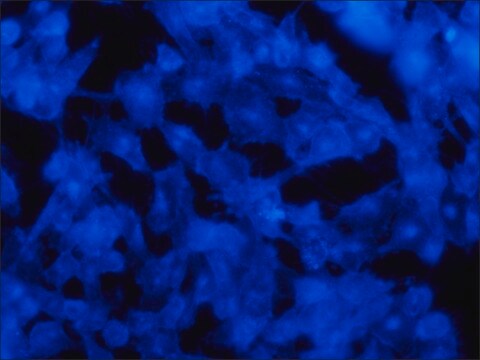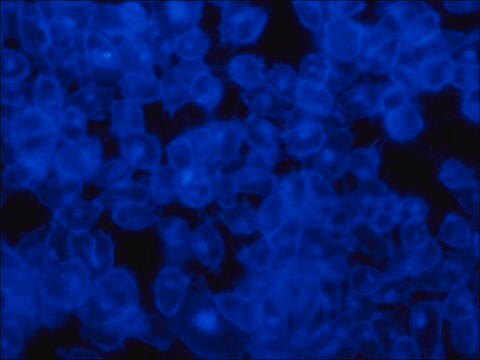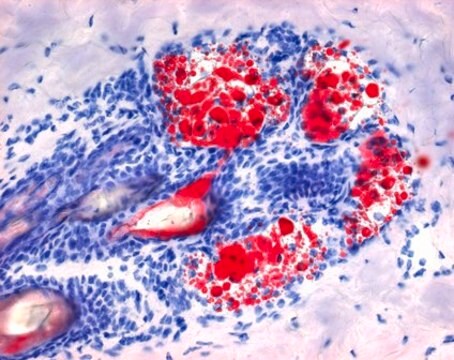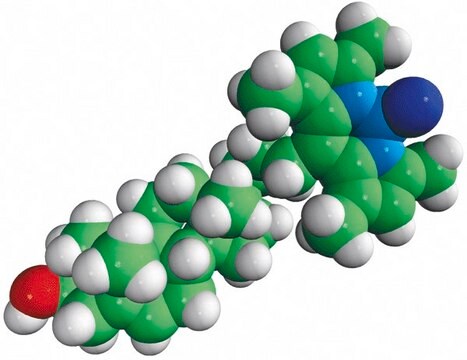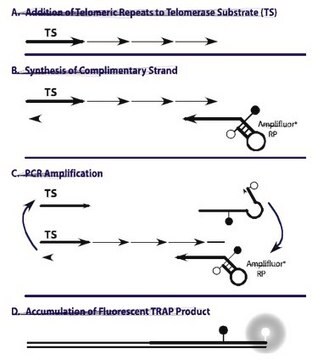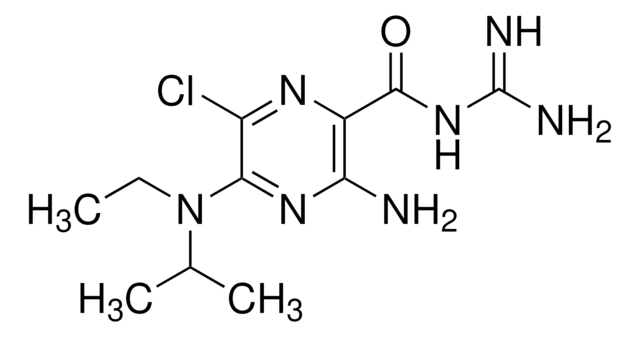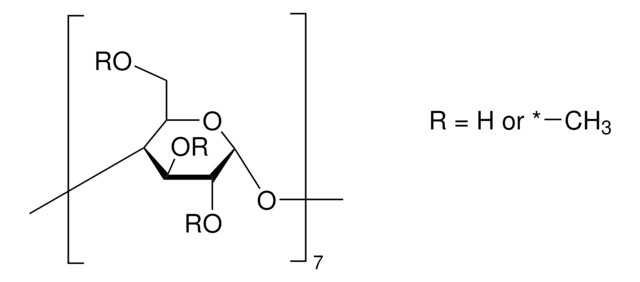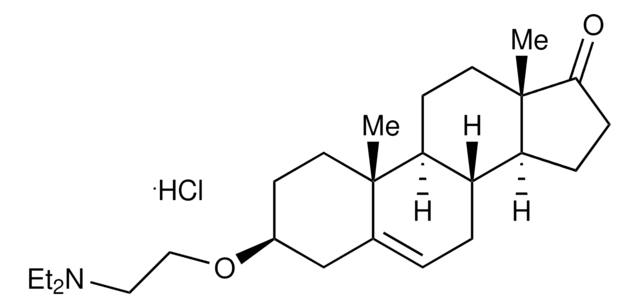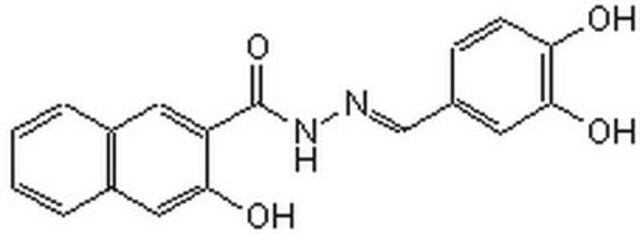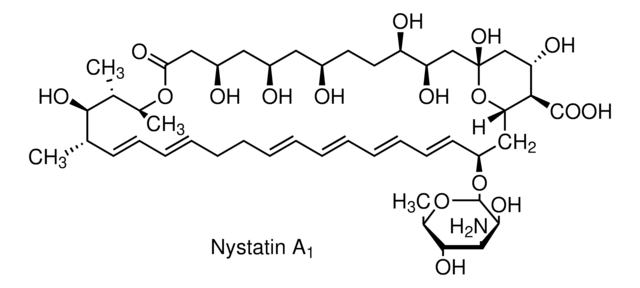SAE0088
Filipin complex ready made solution
from Streptomyces filipinensis, 5mg/ml in DMSO based solution
Synonyme(s) :
Filipin solution
Se connecterpour consulter vos tarifs contractuels et ceux de votre entreprise/organisme
About This Item
Code UNSPSC :
12352200
Nomenclature NACRES :
NA.77
Produits recommandés
Essai
≥90% (HPLC)
Forme
ready-to-use solution
Conditions de stockage
protect from light
Conditions d'expédition
dry ice
Température de stockage
−20°C
Description générale
Filipin Complex, the collective name given to family of isomeric polyene macrolides isolated from cultures of S. filipinensis, with Filipin III being the majority part of the complex.
Application
Filipin complex readymade solution has been used in the staining of HeLa cells for cytoskeletal imaging.
Filipin has been used in a double staining procedure as a probe for the detection of lipoproteins in polyacrylamide gel and immobilized on nitrocellulose membranes. It is also widely used to localize and quantitate unesterified cholesterol by virtue of a specific fluorescent complex.
Actions biochimiques/physiologiques
Filipin is an antibiotic with antifungal functionality. Filipin complex has been found to alter cell membrane structure by interacting with the membrane sterols ergosterols and cholesterol. On binding to cholesterol, filipin shows fluorescence shift. As such, filipin complex has become a useful tool for diagnosis of Niemann-Pick type C disease, and for detection and quantification of cholesterol in cell membranes and lipid quantification in brain.
Autres remarques
Filipin complex ready made solution is very sensitive to air and light. Upon receipt aliquot and store at -20°C. Avoid freeze thaw cycles.
Filipin complex is used in various concentrations depending on the specific protocol used. Dilute 5mg/ml stock solution with appropriate buffer according to the used protocol.
Filipin complex interaction with cholesterol alters the absorption and fluorescence spectra, for visualization with a fluorescence microscope use excitation at 340-380 nm and emission at 385-470 nm (Filipin fluorescent staining photo-bleaches very rapidly, thus the sample should be analyzed immediately).
Filipin complex is used in various concentrations depending on the specific protocol used. Dilute 5mg/ml stock solution with appropriate buffer according to the used protocol.
Filipin complex interaction with cholesterol alters the absorption and fluorescence spectra, for visualization with a fluorescence microscope use excitation at 340-380 nm and emission at 385-470 nm (Filipin fluorescent staining photo-bleaches very rapidly, thus the sample should be analyzed immediately).
Code de la classe de stockage
10 - Combustible liquids
Classe de danger pour l'eau (WGK)
WGK 2
Point d'éclair (°F)
188.6 °F - closed cup
Point d'éclair (°C)
87 °C - closed cup
Faites votre choix parmi les versions les plus récentes :
Certificats d'analyse (COA)
Lot/Batch Number
Vous ne trouvez pas la bonne version ?
Si vous avez besoin d'une version particulière, vous pouvez rechercher un certificat spécifique par le numéro de lot.
Déjà en possession de ce produit ?
Retrouvez la documentation relative aux produits que vous avez récemment achetés dans la Bibliothèque de documents.
Les clients ont également consulté
Filipin recognizes both GM1 and cholesterol in GM1 gangliosidosis mouse brain
Arthur JR, et al.
Journal of Lipid Research, 52(7), 1345-1351 (2011)
The pentaene macrolide antibiotic filipin prefers more rigid DPPC bilayers: a fluorescence pressure dependence study
Castanho MRB, et al.
Biochimica et Biophysica Acta - Biomembranes, 1419(1), 1-14 (1999)
Analysis of cholesterol trafficking with fluorescent probes
Frederick R. Maxfield and Daniel Wustner
Methods in Cell Biology, 367-393 (2012)
A FRET sensor of C-terminal movement reveals VRAC activation by plasma membrane DAG signaling rather than ionic strength
Konig B, et al.
eLife, 8, e45421-e45421 (2019)
Nicole Collette et al.
Molecular therapy. Methods & clinical development, 23, 286-295 (2021-11-04)
Targeting host factors for anti-viral development offers several potential advantages over traditional countermeasures that include broad-spectrum activity and prevention of resistance. Characterization of host factors in animal models provides strong evidence of their involvement in disease pathogenesis, but the feasibility
Notre équipe de scientifiques dispose d'une expérience dans tous les secteurs de la recherche, notamment en sciences de la vie, science des matériaux, synthèse chimique, chromatographie, analyse et dans de nombreux autres domaines..
Contacter notre Service technique